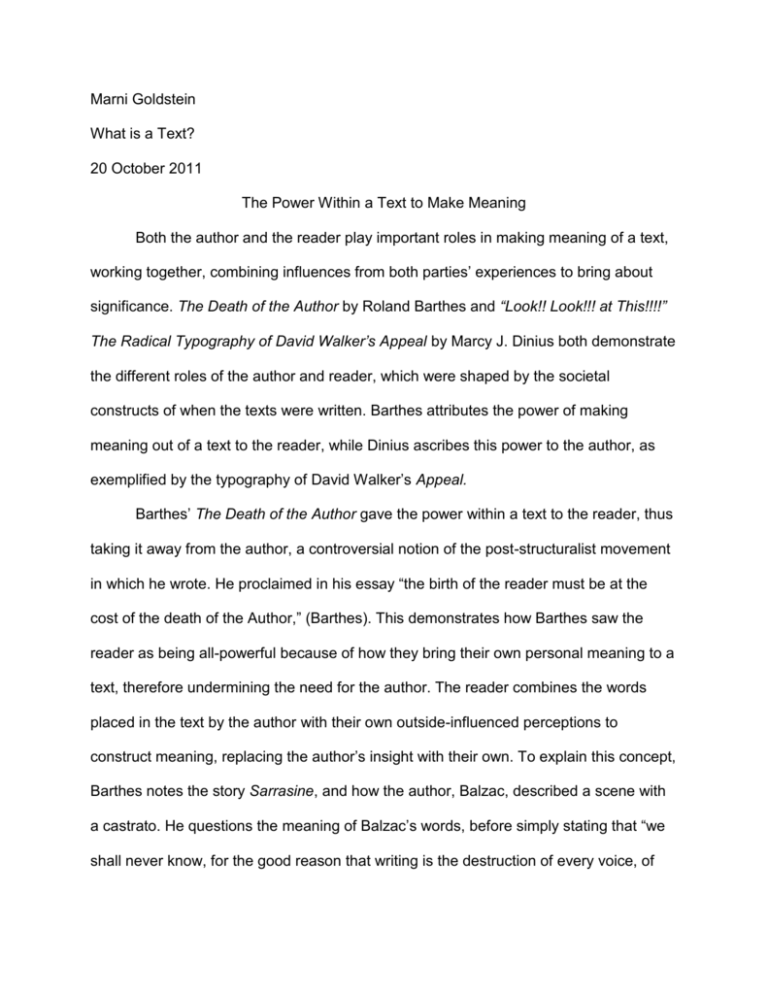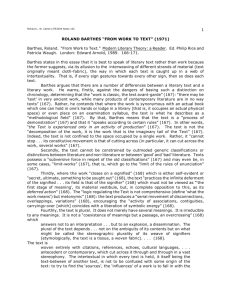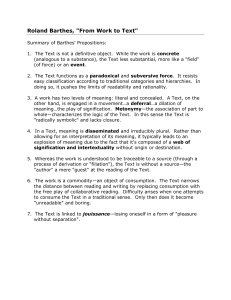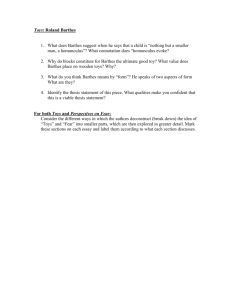Goldstein_TEXTmidterm
advertisement

Marni Goldstein What is a Text? 20 October 2011 The Power Within a Text to Make Meaning Both the author and the reader play important roles in making meaning of a text, working together, combining influences from both parties’ experiences to bring about significance. The Death of the Author by Roland Barthes and “Look!! Look!!! at This!!!!” The Radical Typography of David Walker’s Appeal by Marcy J. Dinius both demonstrate the different roles of the author and reader, which were shaped by the societal constructs of when the texts were written. Barthes attributes the power of making meaning out of a text to the reader, while Dinius ascribes this power to the author, as exemplified by the typography of David Walker’s Appeal. Barthes’ The Death of the Author gave the power within a text to the reader, thus taking it away from the author, a controversial notion of the post-structuralist movement in which he wrote. He proclaimed in his essay “the birth of the reader must be at the cost of the death of the Author,” (Barthes). This demonstrates how Barthes saw the reader as being all-powerful because of how they bring their own personal meaning to a text, therefore undermining the need for the author. The reader combines the words placed in the text by the author with their own outside-influenced perceptions to construct meaning, replacing the author’s insight with their own. To explain this concept, Barthes notes the story Sarrasine, and how the author, Balzac, described a scene with a castrato. He questions the meaning of Balzac’s words, before simply stating that “we shall never know, for the good reason that writing is the destruction of every voice, of every point of origin. Writing is...the negative where all identity is lost, starting with the very identity of the body writing” (Barthes). By saying this, Barthes asserts that readers are unable to truly know Balzac’s intended meaning of the text, thus the author’s identity is lost as soon as they begin writing. As readers, we often look to the author for an explanation of their text. Barthes, however, rejects this notion and removes the power from the author, and affirming it in the reader. In contrast to Barthes, Dinius attributes the power of making meaning to the author. In her essay, she analyzes Walker’s Appeal to the Coloured Citizens of the World, a radical African American pamphlet that condemns slavery and racial discrimination in the United States. This pamphlet, according to Dinius, “is not only ideologically ambitious and historically significant but also typographically radical. [It] is a graphic riot of italics, small and full capitals, exclamation points, and pointing index fingers” (Dinius). Walker punctuated and visually manipulated his words in a way that stood out to the eye; for example, he wrote certain words in capitals and ended certain sentences with a number of exclamation points. These typographical elements were all used by Walker in an attempt to guide the reader and “enable readers...to internalize Walker’s voice, his argument, and his emotions with the proper inflections...so that his pamphlet would broadcast his message as widely as possible…” (Dinius). This asserts the power of the author because Walker meticulously placed each typographical element there for a reason, to ensure that readers would understand his intended message within the text. Walker powerfully utilized typography to control and assert his voice as the author. By raising the capitalization of words and increasing the number of exclamation points after phrases, the reader became able to hear Walker’s voice rise with the anger and passion of the words. Walker powerfully inserted his voice into the text, further establishing his power as the author. When describing Walker’s writing style, Dinius notes, that “readers can virtually hear his rising voice and anger”. This shows how Walker saw the importance of inserting his voice into the text. Because writing this pamphlet was very dangerous at the time, it was important that he command authority over the text to ensure the message would be received. The outbursts with excessive exclamation points show the fear, anger, and emotion of the author, a Black man who had suffered the very atrocities that he wrote about. The power of the author over the text allows for the strong deliverance of the intended message. The societal constructs surrounding the texts influence whether the author or reader has the power of constructing meaning. This can explained by Lloyd F. Bitzer’s concept of the rhetorical situation, which describes how an “exigence”, or moment in which something happens, is necessary to cause someone to deliver a message. By examining the rhetorical situations surrounding both Walker and Barthes, the differences in power between the reader and author become evident. The societal construct surrounding Barthes’ writing greatly influenced his theory that the power within a text belongs to the reader. In 1968, liberal student uprisings occurred across Europe. This monumental time in history demonstrates how society began questioning authority. Barthes, a post-structuralist, rejected the new-criticism notion that texts should be scientifically analyzed, which ultimately elevated the author to a prominent status of supremacy. In The Death of the Author, he writes, “The explanation of a work is always sought in the man or woman who produced it,” (Barthes). This shows how often readers view the author as an authority figure, and regard the meaning of the text as a finite explanation given by this authority. Society has conditioned readers to constantly look for the “right” answer, the single meaning that is supposed to be found in the text. Barthes, who was also influenced by Marxist ideology which aimed at giving power to the people, viewed the author as an authority figure that needed to be removed. By removing authority, Barthes rejected the idea that the author has power, thus instilling it in the reader. He believed that the reader made meaning of text, as opposed to the author. The student uprisings, Marxist theory, and the poststructuralist movement all acted as the exigence for Barthes to deliver his message in The Death of the Author, thus influencing his theory about the power of the reader. Society during Walker’s time also influenced the roles of both the author and reader. In 1829, when Walker wrote his Appeal, African-Americans were enslaved in the southern United States. They had virtually no rights, suffered discrimination, and were treated as an inferior race to the White people. Many Black people were illiterate and the few that could read, were unable to read well. This contributed largely to the power of the author to construct meaning in the text. Walker knew the literacy levels of his target audience, therefore, his typography was necessary to literally point out his message. Also, because the pamphlet was obviously written by a black man, the reader was unable to detach the author from the text. The discrimination against blacks in the time Walker wrote affected the meaning that the reader procured because they were forced to view the author as a black man and choose their side based upon this distinction. If the reader at the time was white, they would oppose it, whereas if they were black, they would be more likely to identify with it. Walker, however, used his power as the author to deliver his message as forcefully as possible, in hopes that the blacks would understand it and react. The fact that the message depended so heavily on the author demonstrates how powerful the author was in relation to the message. The exigence for Walker to deliver his message was the discrimination of AfricanAmericans, and through her analysis of his text, Dinius explains how it affirmed his power as the author. While both texts differ in their perception of the power of the author, they do both, however, attribute power of making meaning to the reader. Barthes claims, “to give a text an Author is to impose a limit on that text…” (Barthes), which means that text ultimately can be interpreted in many different ways, depending entirely on the reader. Texts are seen as limitless, lacking one set and final meaning. As Barthes explains, “the text is a tissue of quotations drawn from the innumerable centres of culture”(Barthes), therefore readers comprehend text differently because everyone brings to it their own opinions and experiences. This means that the text combines with the reader’s own prior knowledge as they read, so no two readers will ever draw the same meaning from a text. Dinius’ analysis of Walker’s Appeal affirms this concept because every reader of Walker’s pamphlet definitely did not interpret the message the same. Both whites and blacks read Walker’s Appeal, therefore, due to the society of the time, they had very different opinions and experiences. The white people were outraged by it so much that they “passed strict laws regulating slave literacy and the movement of blacks and the texts they wrote” (Dinius). Also, to ensure that more blacks could not read or write similar revolutionary material, “slaves were no longer allowed to work in print shops. And teaching a slave to read became a punishable offense…” (Dinius). This response exemplifies how different readers form different meanings from text. These laws, the consequence of the power of the reader, were implemented to hinder and control the black audience. While the author and reader both posses power over the meaning of a text in different ways, both Barthes and Dinius attest that power also lies within the language itself. In The Death of the Author, Barthes writes,“it is language which speaks, not the author; to write is...to reach that point where only language acts..” (Barthes), meaning that language holds so much power that it can act on its own, asserting its own meaning. This statement relates to Walker’s Appeal because the typography throughout the piece causes the writing to often speak for itself. Dinius describes how the pointing finger, or manicule, “allows Walker’s text literally to point the finger of accusation at whites for the barbarity of slavery and at blacks for their failure to resist,”(Dinius). Blacks at this time would never be able to actually point a finger at whites in accusation, therefore, the language and typography of the text act out this action. The manicule symbol asserts such power in the text, that when combined with the words, it designates meaning. Barthes’ The Death of the Author and “Look!! Look!!! at This!!!!” The Radical Typography of David Walker’s Appeal by Marcy J. Dinius both describe how meaning is made within a text, attributing the power to either the reader or the author. Barthes’ theory attributes the reader with the power of finding meaning in a text, while insistently removing it from the author. Dinius, in contrast, describes the power of the author through her analysis of Walker’s radical pamphlet, but also attests to the power of the reader. The society in which writing took place also influenced the roles of both the reader and author within the texts, and use of the language itself proved powerful to both Barthes’ and Dinius’ claims. In conclusion, various factors, such as the power of the reader and the author, the society in which it’s written, and the power of the language itself all influence how meaning is made within a text; additionally, the amount of power held by these factors individually further shapes how this meaning is made. Works Cited Barthes, Roland. "The Death of the Author." Print. Dinius, Marcy J. "“Look!! Look!!! at This!!!!” The Radical Typography of David Walker’s Appeal." Modern Language Association of America, 2011. Print.







